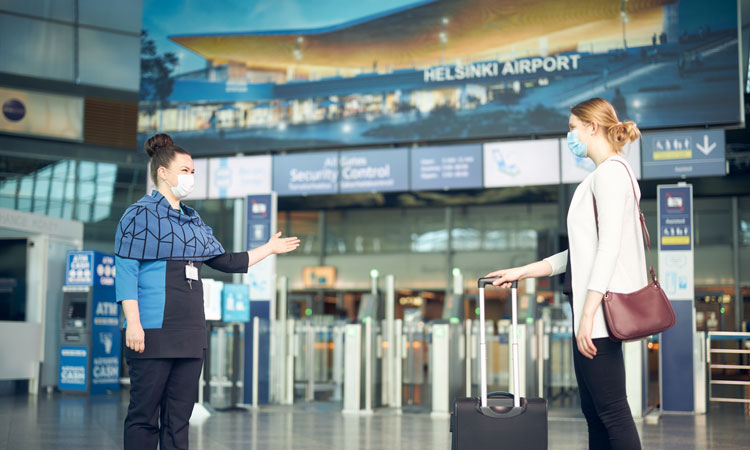Information shared is performance improved at Helsinki Airport
- Like
- Digg
- Del
- Tumblr
- VKontakte
- Buffer
- Love This
- Odnoklassniki
- Meneame
- Blogger
- Amazon
- Yahoo Mail
- Gmail
- AOL
- Newsvine
- HackerNews
- Evernote
- MySpace
- Mail.ru
- Viadeo
- Line
- Comments
- Yummly
- SMS
- Viber
- Telegram
- Subscribe
- Skype
- Facebook Messenger
- Kakao
- LiveJournal
- Yammer
- Edgar
- Fintel
- Mix
- Instapaper
- Copy Link
Posted: 13 September 2021 | Timo Järvelä | No comments yet
Timo Järvelä, Vice President of Passenger Experience and Processes for Helsinki Airport, explains how Finavia’s new Airport Operational Status system is helping them to improve operational productivity and efficiency.


Airport company Finavia has been developing its situational awareness processes and practices together with its airport community for almost 10 years now. The Airport Operational Status (AOS) system is a shared information and communications channel used throughout Finavia’s airport community to improve both the performance and predictability of operations through shared situational awareness. Built together with Siili Solutions, a digital solutions partner, the system has been designed from the ground up to manage Helsinki Airport (HEL) and the entire network of regional airports in Finland and has now been in use for over five years. To improve operational visibility and bring the airport system even further into the modern era, Finavia teamed up with Siili Solutions to create a bespoke system that has since revolutionised operations throughout Finavia’s network.
Smooth operations through optimal efficiency
Today, Finavia uses the AOS system to collect, classify and publish data. There are various IT integrations with internal and external data sources which automatically provide data inputs, and all data is shown on a dashboard where users can choose specific widgets to get a more detailed view of their chosen processes. To effectively deliver information to users in an understandable and timely manner, we utilise data processing, aggregation and data transformation with business rules and machine learning to notify systems or users. The application platform is built with a micro services approach to provide future‑proof flexibility. Split into apps for end users and tools for operators, the AOS system is used every day by around 4,000 users; 25 per cent of which are Finavia personnel, 75 per cent of which are made up by the rest of the airport staff. Between them, they handled 2,500 events in 2020 to maximise the quality of customer experience – the core of what we do.
Finavia values improvements in productivity wherever possible, because it means better service quality, punctuality and a much more efficient utilisation of capacity. All of that translates through to a much smoother experience for our passengers and for airlines.
Higher quality information frees up human resources
One of the key benefits of the AOS system is the extent to which it frees up human resources and provides a high level of flexibility to staff. When airport staff have high-quality information, it enables them to manage various processes or situations in the most efficient way. When a customer services representative is guiding passengers at the gate area, for example, they need exact, real-time information in order to be able to provide the best assistance possible. The use of centralised and dedicated information saves tens of meetings per week, and also leads through to significant cost-savings. These savings come from the ability to create instructions for others and quickly share them with the relevant people.
At Helsinki Airport, for example, the operations of 2020 – the year of the COVID-19 pandemic – were handled by one to two full-time employees at any one time, rotating from a pool of 12 to 15. Without the AOS system, the need for full-time employees would have been higher due to the continuous crisis management and daily exceptions in airport routines.
The system in action: the COVID-19 pandemic
The pandemic actually provided one of the best examples of the AOS system in practice. The pandemic led to constantly changing information, safety rules, passenger processes, health incidents and instructions, which served to highlight the importance of fast, efficient, mobile communication between every airport community member. For Finavia, this sort of communication has been possible because the system works seamlessly across both desktop and mobile interfaces.
A particular challenge in the case of the pandemic has been the integration of new stakeholders outside of normal airport operations, such as health authorities and ministries, into airport operations. Because the AOS system works in real-time, information is always up-to‑date, and this has removed a potential barrier to communicating with outside receivers.
Integration with the fire alarm is another good example of how the system gets the right people involved at the right time. When there is an alarm, relevant decision-makers and airport staff are informed with a special event via the system. Everybody else is made aware that there is special event going on, which could affect operations.
In the case that the alarm escalates to a real fire situation and evacuation, then Finavia airport crisis management is organised via AOS. It is, of course, important to note that the AOS system does not replace the actual fire alarm system itself – that still comes in the form of traditional loudspeakers.
Avoiding and handling crises
It is not just everyday situations that require improved situational awareness. In special situations, it is crucial for airport staff to have a true picture of what is happening around them in order to handle those situations quickly and safely.
From an operational perspective, a system failure to respond to a crisis (e.g. to a pandemic) can happen at different levels of severity. With the AOS system, airport staff can manage and communicate any level of severity for more effective management. Likewise, the system can be used to adjust the confidentiality level of information for the closer handling of potentially delicate situations.
The AOS system allows staff to see all of the useful key performance indicators from different processes so that they can be warned before situations occur. In other words, staff can make decisions on such timely, high-quality information that problematic situations can be solved before they ever materialise.
The AOS system is ready for use by other traffic sectors
The AOS system, as a solution, allows our airport community to communicate and build situational awareness and track events in real-time. This allows us to meet a need for faster incident response and lower negative operational impact. But these needs are also present in other traffic sectors.
Having achieved such positive results with the solution, Finavia is now aiming to commercialise it, not only for use in aviation, but for other transport‑based industries, such as maritime and rail. In fact, the system platform is already in use in other businesses, such as cleaning.
It is not just everyday situations that require improved situational awareness. In special situations, it is crucial for airport staff to have a true picture of what is happening around them in order to handle those situations quickly and safely”
The cloud-based nature of the IT platform and management means that the AOS system can be implemented relatively quickly. The system is not designed with long-term data storage in mind, but rather collaboration, real-time operational data and predictive aspects. It is enterprise-grade, GDPR compliant, run in a secure environment and 100 per cent in the cloud.
The system allows data integration with publicly available, open-source data through the most common Enterprise Integration Patterns, such as Rest APIs, point-to-point and message APIs. Additionally, user management and authentication support standard integration patterns using Lightweight Directory Access Protocol or Active Directory.
The aviation industry is complex, as are other traffic-based sectors. Complex industries with various interests, processes, organisations and businesses need top rate shared situational awareness to understand their ecosystems and how they are performing. With fast and accurate information, challenges can be mitigated before they arise. With better understanding, we can make better decisions. That is the bedrock of smooth and successful operations.


Issue
Related topics
Airport crisis management, Airside operations, Communication Technology, Passenger experience and seamless travel, Safety, Security, Terminal operations


















